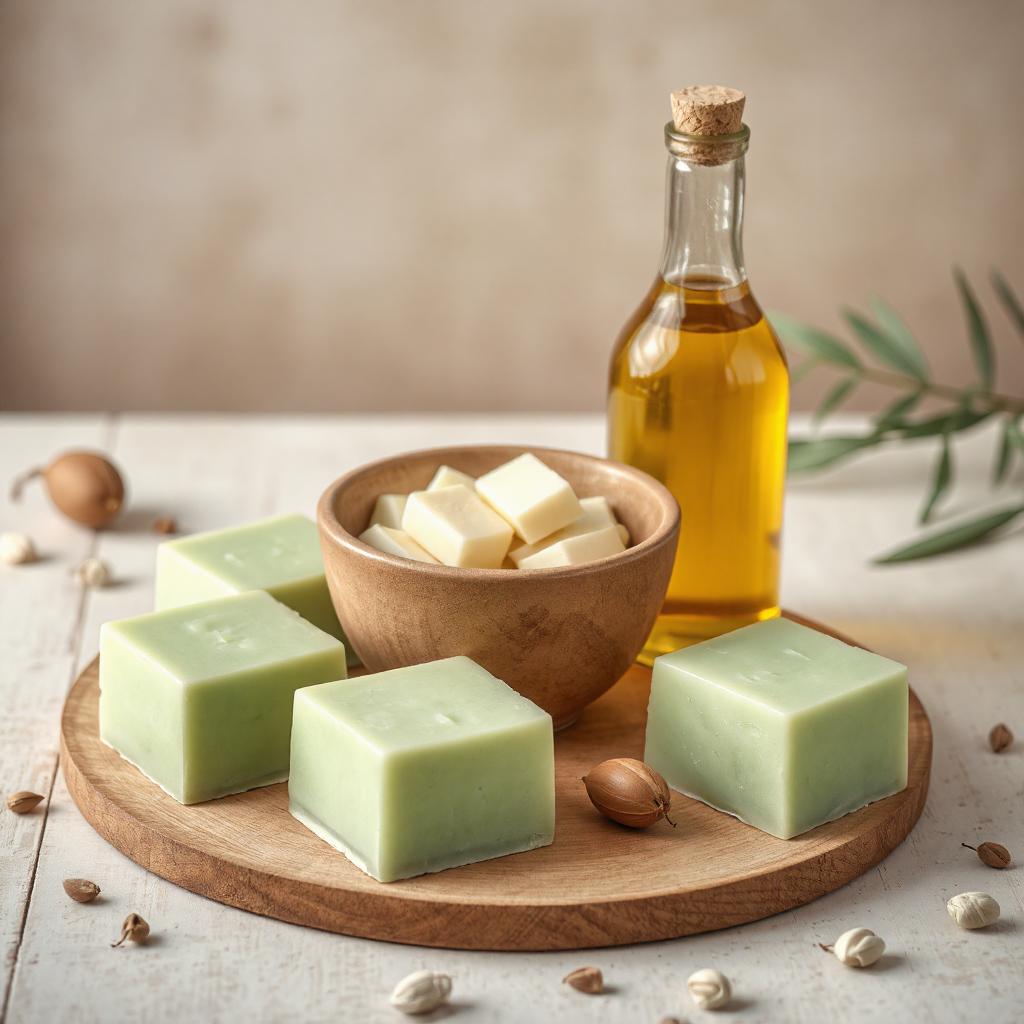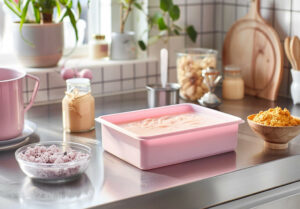Recipe for Cold Saponified Soap: “Velours d’Olive et Coco” (Olive and Coconut Velvet)

At Planète Savons, we think of everything to make saponification accessible and suitable for everyone. That’s why we offer two versions of this recipe: one using ready-to-use soda lye, ideal for its simplicity, and the other based on soda microbeads, enabling you to prepare your own soda solution with precision.
Both techniques offer identical results in terms of soap quality, leaving everyone free to choose the method that suits them best.
It’s up to you to find your favorite!
Today we bring you a unique recipe: “Velours d’Olive et Coco”, a soap with exceptional benefits.
Thanks to olive oil and coconut butter, this soap provides an incomparably soft sensation, leaving the skin nourished and moisturized, just like after applying a body lotion.
Benefits of the main ingredients
Lampante Olive Oil
- Rich in fatty acids, it moisturizes and softens the skin.
- Contains natural antioxidants to protect against external aggressions.
- Perfectly suited to dry, sensitive skin.
Organic Coconut Butter
- Produces a fine, dense, creamy mousse.
- Deeply nourishes the skin thanks to its saturated fatty acid content.
- Provides gentle cleansing while respecting the skin’s natural balance.
Green Clay
- Absorbs impurities and purifies the skin.
- Particularly beneficial for combination to oily skin.
Equipment required
Before you start, make sure you have all the materials you need and have them ready before you begin your recipe:
| Equipment | Usefulness |
|---|---|
| 1 L and 500 ml beakers, small bowl | For measuring oils, soda and clay |
| Silicone spatula | Mixing ingredients. |
| Cosmetic thermometer | Oil and soda temperature control. |
| Cosmetic precision scale | Precise weighing of ingredients. |
| Parchment paper | Protects soap during drying. |
| Individual or cavity moulds | Gives shape to soaps. |
| Hand blender | To reach the track quickly. |
| Drying box | For optimal soap curing. |
Safety Precautions
- Wear gloves, goggles and a mask when handling caustic soda (even if it’s soda lye).
- Work in a well-ventilated area to avoid soda fumes.
- Store materials out of the reach of children and pets.
Making your recipe: 30% Soda Lye version
Ingredients:
- Lampante Olive Oil: 375 g
- Organic Coconut Butter: 125 g
- Soda lye 30%: 233 g
- Green Clay: 15 g
- Fragrance (or essential oil): 15 g
Steps :
- Prepare your ingredients: Weigh each ingredient precisely.
- Heat the oils: In your 1-liter beaker, melt the olive oil and coconut butter in a bain-marie or microwave (350-450 watts). The temperature should not exceed 50°C.
- Add the clay: Incorporate your clay into the melted oils and mix lightly to distribute evenly.
- Mix the washing soda: In your 500 ml beaker, weigh out your washing soda and pour it& gently with your spatula into the warm oils. Your oils should be at 45 degrees maximum.
- Reach the trace: Take your blender and blend in bursts until you reach the famous “trace”.
- Add the fragrance: once you have obtained your “trace”, mix gently with a spatula to prevent the paste from thickening too quickly.
- Pour into molds: Carefully fill each cavity or individual mold with your spatula.
- Rest: Cover with greaseproof paper and leave to harden for 24 to 48 hours in a dry, well-ventilated room.
- Unmold and seal: Place unmolded soaps in your Planète-Savons drying box and leave to rest for 4 to 5 weeks.
How to make your recipe: Version with Sodium Micro-Pearls (NaOH)
Ingredients:
- Lampante Olive Oil: 375 g
- Organic Coconut Butter: 125 g
- Distilled water or hydrosol: 160 g
- Soda microbeads (NaOH): 70 g
- Green Clay: 15 g
- Fragrance (or essential oil): 15 g
Differences in stages :
- Protect yourself: Put on your safety goggles and mask.
- Preparing the soda solution: Take a glass beaker and pour in distilled water (bottled or hydrosol), then add the soda microbead (never the other way round).
- Dissolve the micro-beads by stirring them with your spoon.
- Heat your oils and butters: Your vegetable oils and butters should be heated to between 42 and 45 degrees maximum. Your washing soda should be between 38-40 degrees.
- Mix well: Add your soda solution to your hot oils while mixing gently with your spatula.
- Mixing: Blend your soap paste in small batches until you reach a “trace” consistency.
- Add : Once you’ve mixed your soap paste, add your chosen fragrance or essential oil.
- Pour into molds: Carefully fill each cavity of your minimum 7-cavity mold or individual mold with your spatula.
- Rest: Cover with greaseproof paper and leave to harden for 24 to 48 hours in a dry, well-ventilated room.
- Unmold and seal: Place the unmoulded soaps in your Planète-Savons drying box and leave to rest for 4 to 5 weeks.
Tips for optimum results
- Trace too fast? Reduce blender speed. Don’t add any more fragrance or EO.
- Moulds that are difficult to unmould? Place in the freezer for 30 minutes before unmolding.
- Prolonged cure: With 2/3 olive oil, a 5-week course is ideal.
Storage and use
- Store your soaps in your drying box, in a dry, dark place.
- Use a soap dish to extend their life.
- Suitable for all skin types, even the most sensitive.
FAQs on Cold Saponification
- Why cold saponification?
It preserves the properties of the ingredients for a natural, nourishing soap. - How to test pH?
Use pH paper after the treatment: a pH between 8 and 10 is optimal. - Can I use another clay?
Yes, white or pink clay can be used to vary the benefits. - Can oils be replaced?
You can replace coconut butter with shea butter for an even softer soap. However, if you use a different vegetable oil or butter, you’ll need to run your recipe through the SOAPCALC calculator again (see our article on Vegetable Oils). - What if my soap doesn’t harden?
Check the soda proportions and allow to dry longer. - How to choose a fragrance?
Choose fragrances or essential oils from Planète-Savons specially designed for cold saponification.



0 Comments